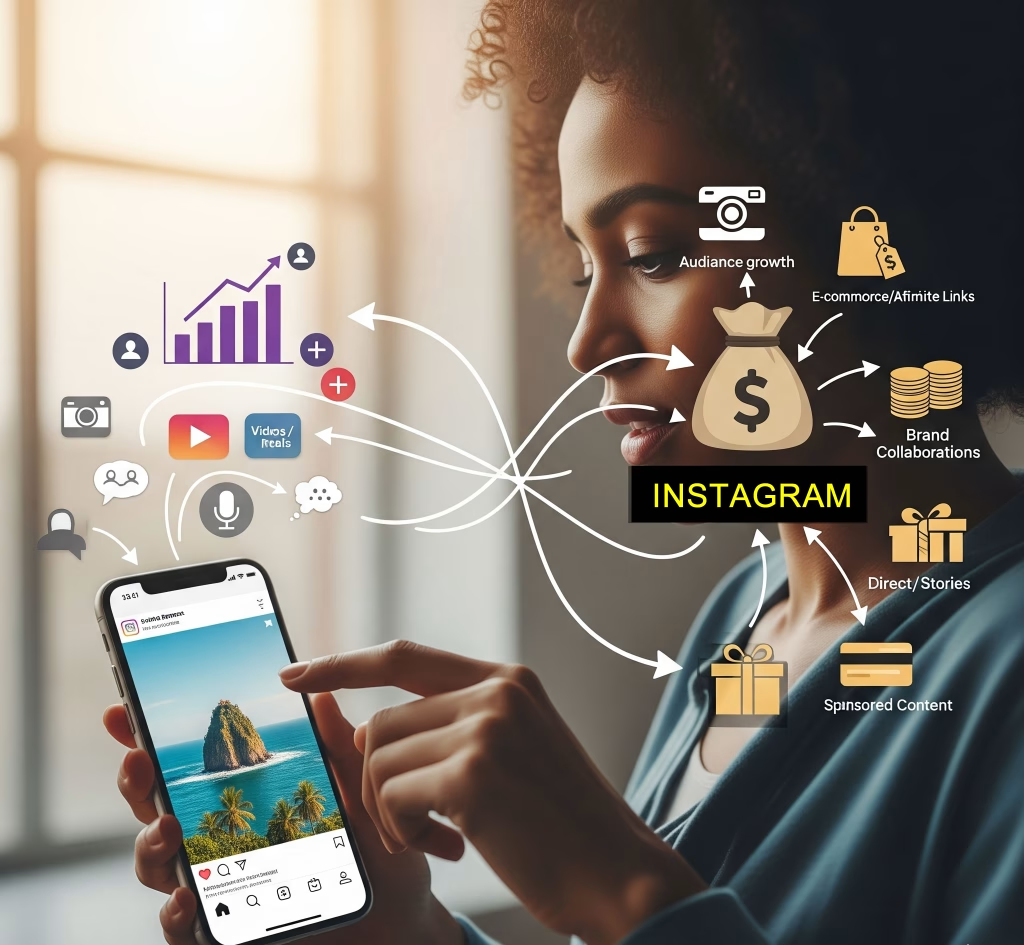
Instagram Content Creation and Monetization Overview
This overview condenses the full Instagram monetization guide into key points, actionable advice, and strategic considerations. It serves as a reference for creators aiming to produce high-quality content, grow an engaged audience, and generate multiple revenue streams.
Key strategy pillars
- Content strategy fundamentals: define a niche publish Reels Stories and feed posts consistently use trending effects and relevant hashtags
- Audience engagement and growth: reply to comments and messages use polls stickers and interactive formats to increase visibility
- Monetization methods: branded partnerships affiliate links digital products Live badges Reels bonuses Instagram Shop
Platform tools and updates
- Instagram Earn Money Tools: official feature list and eligibility
- Buffer guide 13 ways to monetize Instagram: practical tactics for creators
- Outfy guide to monetizing Instagram: selling products and UGC opportunities
Community insight
Real creator tips on starting lean and scaling with simple offers.

1. Content Strategy Fundamentals
- Choose Your Niche: Align with expertise and interests. Popular niches include lifestyle, beauty, fitness, travel, tech, and education.
- Content Types: Feed posts for storytelling or tutorials, Reels for short, engaging videos, Stories for behind-the-scenes content and interaction.
- Consistency: Post 3–5 feed/Reels per week and daily Stories to maintain visibility.
- Algorithm Optimization: Use trending music, effects, and hashtags (5–15 per post) for discoverability.
- Engagement: Respond to comments, DMs, and collaborate with creators in your niche.
2. Camera and Equipment Essentials
High-quality visuals are essential for Instagram because the platform is primarily visual and users scroll quickly. Even if your content is informative or entertaining, poor image quality reduces engagement and perceived authority. Choosing the right camera, lens, and accessories, and understanding exposure settings is critical for monetization-ready content.

- Cameras: Smartphones (iPhone 17/18, Samsung Galaxy S26, Google Pixel 12) for beginners; Sony ZV-1, Canon EOS M50 Mark II, Sony A7 VII, Panasonic GH6 for advanced creators.
- Settings: 1080p 30fps standard, 60fps for action; f/2–f/4 for talking-heads; ISO 100–400 indoors; white balance 3200–5600K depending on light source.
- Lenses: Wide (24–35mm) for selfies/environment, 50mm for portraits/products, ultra-wide (16–20mm) for travel/room tours.
- Stabilization: Tripods, gimbals, and ring-light stands for steady shots.
3. Lighting and Environment
Lighting is one of the most critical factors for Instagram content. Even the best camera will produce poor results without proper illumination. Good lighting enhances colors, improves skin tones, reduces noise, and gives your content a professional look that attracts followers, brands, and monetization opportunities.
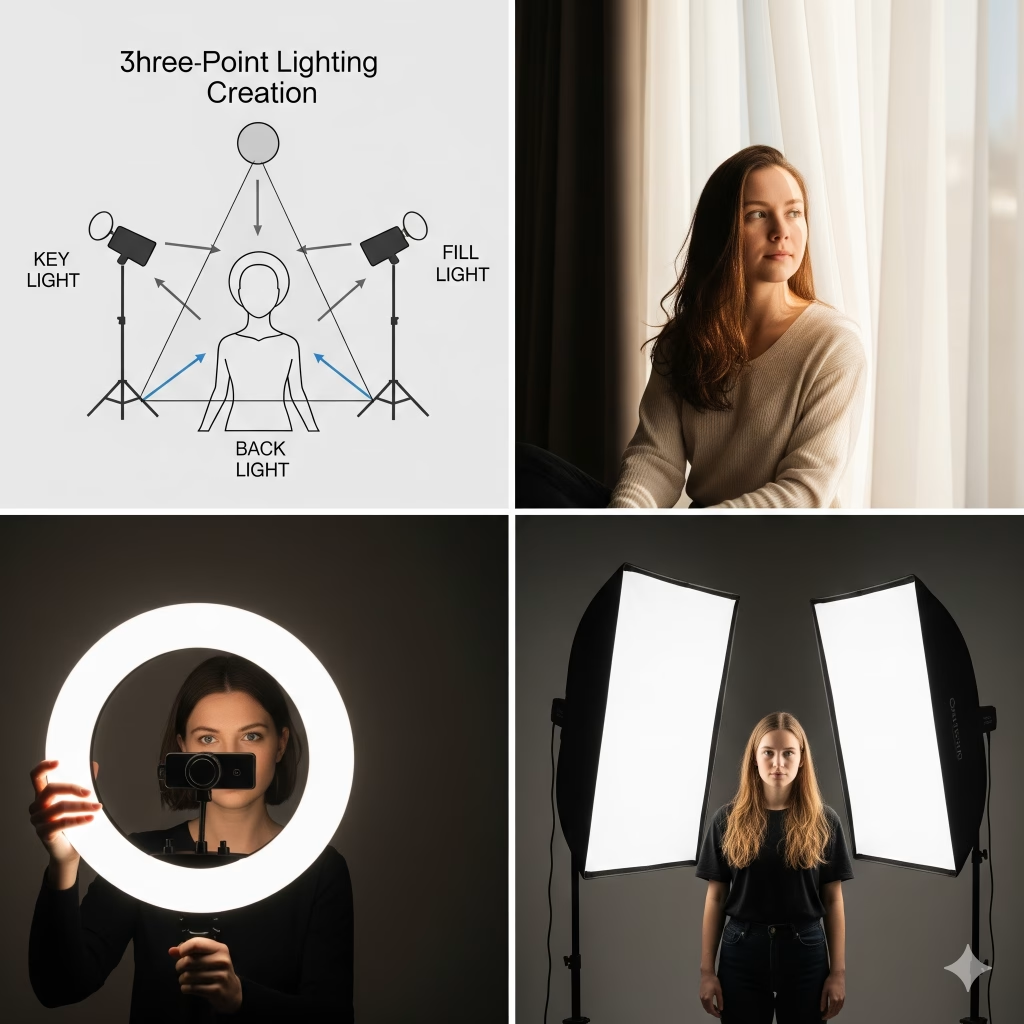
- Three-Point Lighting: Key light (main), fill light (soften shadows), backlight (subject separation).
- Gear: Entry: Neewer Ring Light; Advanced: Aputure Amaran panels with softboxes.
- Natural Light: Use indirect sunlight, golden hour, and diffusion tools like sheer curtains or reflectors.
- Background: Clean, minimal props, strong color contrast, uncluttered for focus on subject.
Practical Tips for Consistency: Always maintain the same lighting setup when filming a series or branded content to ensure consistent quality. Lock in your key and fill light positions, maintain consistent intensity and color temperature, and check lighting before each shoot. Use small LED panels or reflectors to compensate for minor variations in natural light throughout the day.
For detailed lighting tutorials, setup examples, and product recommendations for Instagram creators, see Videomaker Lighting Guides and Wemaxa for influencer-focused, monetization-ready setups.
4. Audio Setup
High-quality audio is often overlooked by Instagram creators, yet it is equally important as visuals. Clear audio improves engagement, makes your content feel professional, and is essential for monetization because brands and sponsors expect high production quality. Instagram content can include voiceovers, dialogue, tutorials, music overlays, and product demos, all of which require precise audio capture and control.
- Microphones: Lavalier (Rode Wireless GO II, Boya BY-M1), USB (Blue Yeti, Shure MV7), Shotgun (Rode VideoMic NTG).
- Placement: Lavalier clipped 15–20cm below chin, shotgun angled at subject, use windshields outdoors.
- Noise Control: Quiet rooms, soft furnishings, acoustic panels, DIY dampening for low-budget setups.
- Levels & Monitoring: Peaks around -6dB, monitor with headphones, sync external recorders with video in post.

5. Editing and Postproduction
Editing is where raw Instagram footage transforms into engaging, monetization-ready content. Even the highest-quality video and audio can fail to attract followers if the postproduction is sloppy. Postproduction for Instagram includes trimming, sequencing, transitions, color correction, audio mixing, captions, and exporting videos optimized for each content type: feed posts, Reels, Stories, and Instagram Video.
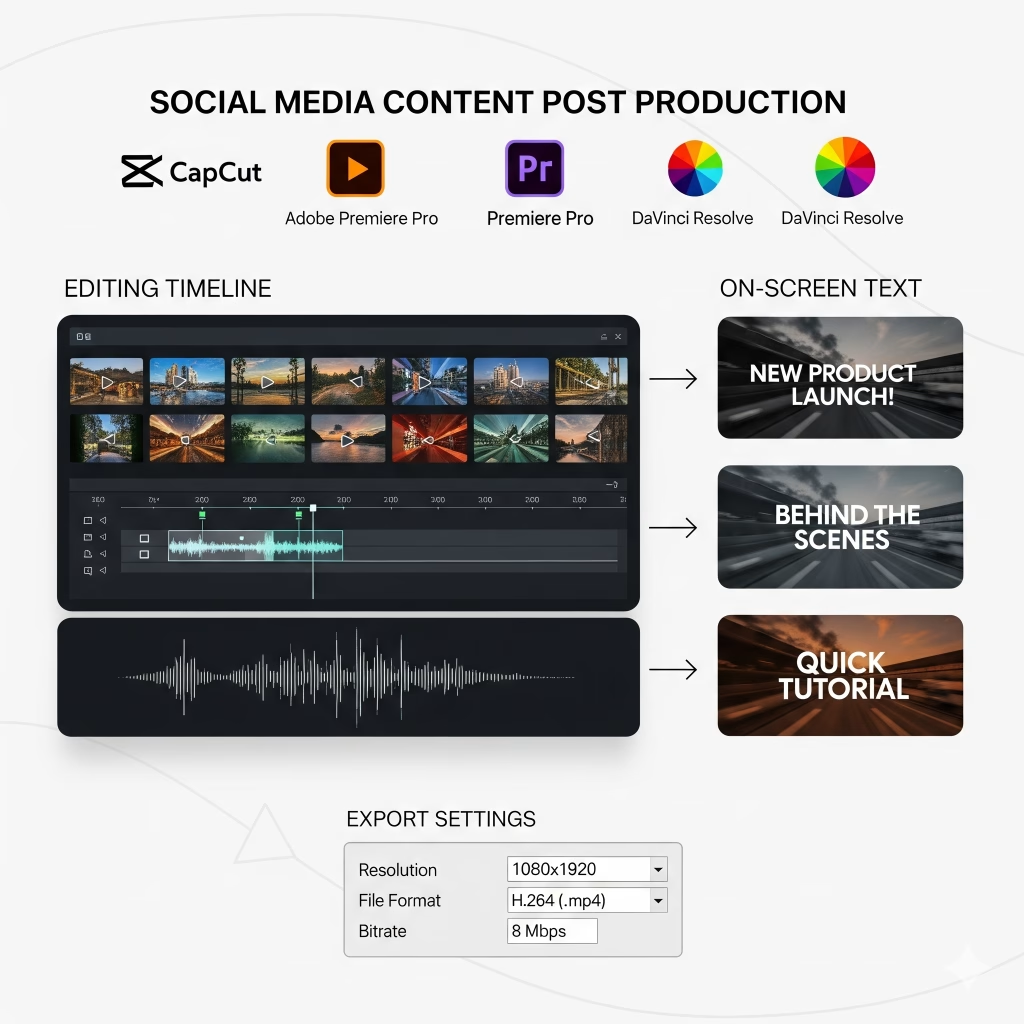
- Software: Mobile: CapCut, Premiere Rush; Desktop: Premiere Pro, Final Cut Pro, DaVinci Resolve.
- Workflow: Organize clips, trim, sequence, add transitions, maintain pacing, apply consistent color grading.
- Audio: Normalize, noise reduction, music balance, AAC 44.1kHz export.
- Captions & Overlays: Use concise text, readable fonts, lower-thirds or watermarks for branding.
- Export Settings: Reels/Stories: 1080×1920, 30–60fps, H.264, 8–12Mbps, AAC stereo; Feed: 1080×1080 or 1080×1350.
6. Monetization Methods
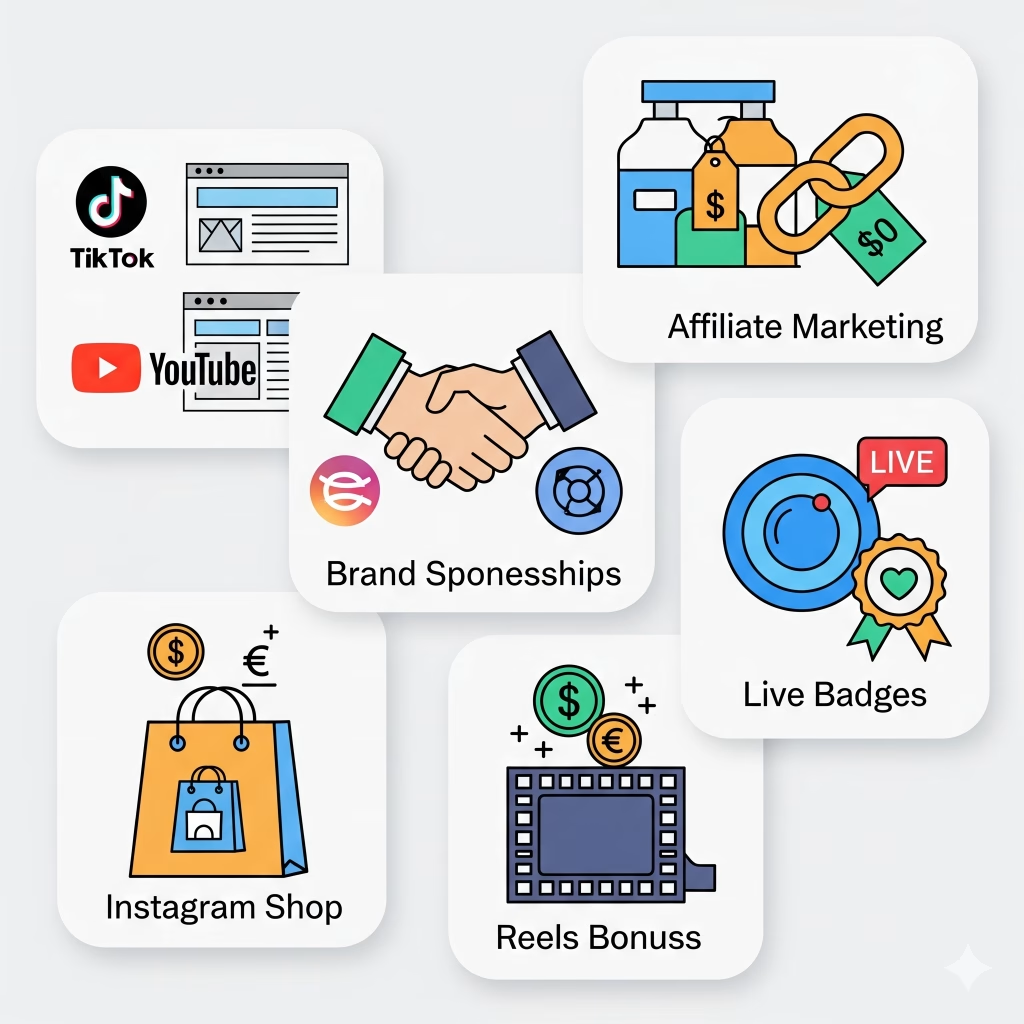
- Brand Sponsorships: Paid posts/Reels, negotiate terms, focus on engagement rate over follower count.
- Affiliate Marketing: Promote products via links or codes, track sales, disclose partnerships.
- Instagram Shop: Tag products in posts/Reels, sell own merchandise or digital goods.
- Reels Bonuses: High-engagement Reels may earn payouts in supported regions.
- Live Badges: Followers purchase badges during live streams for direct support.
- Cross-Platform Monetization: Repurpose content on TikTok, YouTube, personal website, or email lists.
- Analytics & Optimization: Track performance, adjust content types, posting schedule, captions, and hashtags to maximize visibility and revenue.
Oversight and Advice
Successful Instagram monetization depends on integrating professional content creation, consistent audience engagement, and diversified revenue streams. Key takeaways include:
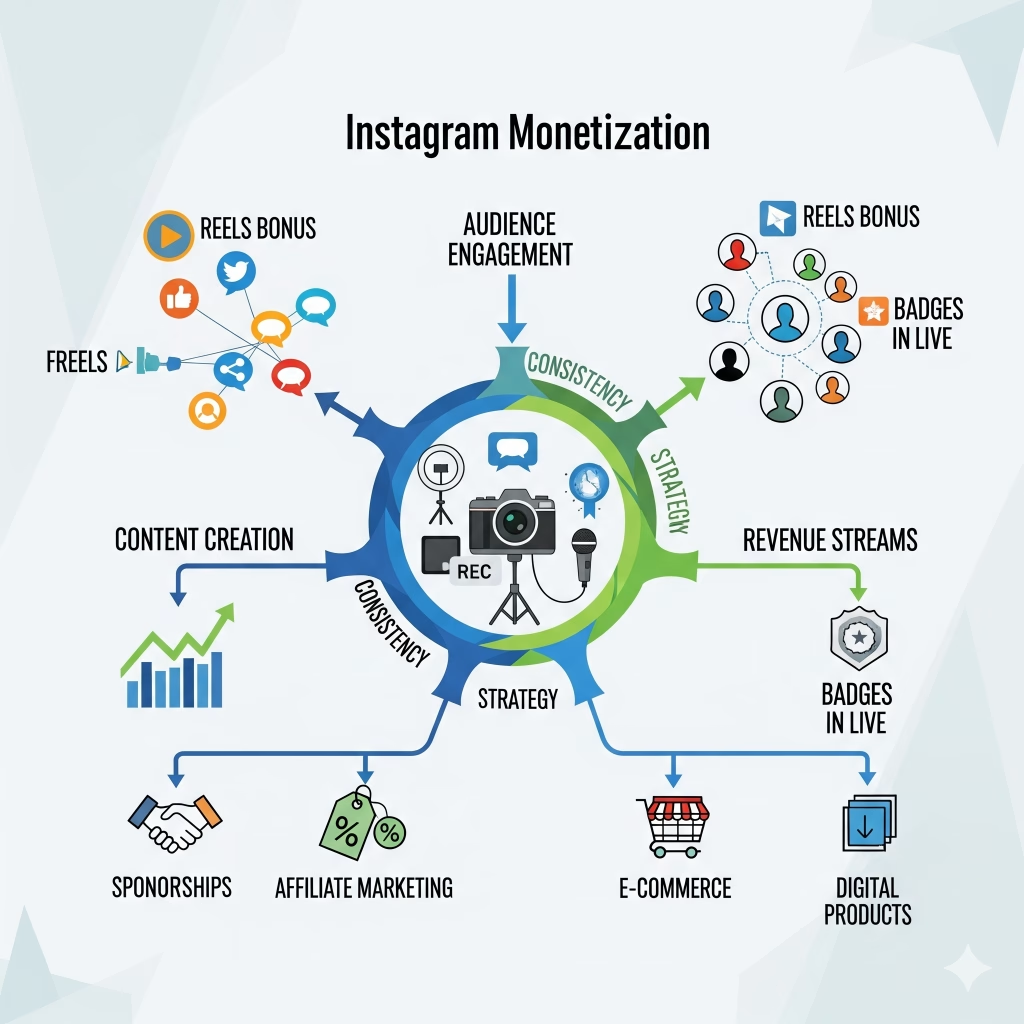
- Prioritize high-quality video and audio, maintaining brand consistency and style across all posts.
- Engage actively with followers, respond to comments and DMs, and collaborate strategically with other creators.
- Use analytics to optimize content, hashtags, posting times, and formats for engagement and monetization.
- Combine multiple revenue streams: sponsorships, affiliate marketing, e-commerce, Reels bonuses, and live badges.
- Repurpose content across platforms to maximize reach and income potential.
- Maintain professional setup: camera, lighting, audio, editing workflow, and postproduction standards.
- Experiment with content types and iterate based on data; high retention and shares drive both growth and monetization.
MAKING MONEY WITH INSTAGRAM COMPLETE GUIDE: CAMERA, AUDIO, PRODUCTION, EDITING AND MONETIZATION
Making Money with Instagram
This Wemaxa guide explains how creators monetize Instagram using native features sponsored content affiliate sales and direct commerce. Instagram remains one of the most lucrative social media platforms for content creators. Unlike TikTok, Instagram offers a combination of feed posts, Stories, Reels, and long-form videos through Instagram Video (formerly IGTV), each with unique engagement mechanics. To monetize effectively, a creator must understand the platform’s algorithm, content types, audience behavior, and revenue opportunities. Monetization on Instagram is multi-faceted, including brand sponsorships, affiliate marketing, product promotion, selling digital goods, and leveraging Instagram’s native monetization features like badges during Live sessions and bonuses for Reels engagement.
Content Strategy Fundamentals: Success begins with understanding your niche. Niches can range from lifestyle, beauty, and fitness to travel, education, and tech. Choose a niche aligned with your expertise and interests because authenticity drives engagement. Once the niche is defined, content should be tailored to audience expectations, but also optimized for Instagram’s algorithm. For example, Reels are favored for short, engaging, scroll-stopping videos, often under 30 seconds, with hooks in the first 2–3 seconds. Feed posts and carousel content work for detailed tutorials, lists, or storytelling. Stories are ideal for behind-the-scenes content, polls, direct interaction, and affiliate promotions.
Audience Engagement and Growth: Monetization is impossible without followers and active engagement. Focus on consistency: post at least 3–5 times per week across feed and Reels, and daily Stories if possible. Leverage trending music, effects, and challenges in Reels for discoverability. Use hashtags strategically: include 5–15 relevant hashtags per post, mixing high-volume and niche-specific tags. Engage actively by responding to comments, DMs, and mentions. Collaboration with other creators in the same niche accelerates growth through audience cross-pollination. Keep analytics in check: Instagram Insights provides data on reach, saves, shares, and profile visits; track which posts generate the highest engagement to refine your strategy.
Revenue Opportunities on Instagram: Instagram monetization can be direct or indirect. Direct monetization includes Instagram Live badges, Reels bonuses (available in select regions), and IGTV ad revenue. Indirect monetization often proves more profitable: brand sponsorships are negotiated based on engagement rates rather than follower counts alone; affiliate marketing enables commission on product links; selling digital goods, courses, or consulting services leverages your authority. Product placement and e-commerce integrations such as Instagram Shopping allow creators to sell physical products directly through the platform. For creators aiming at long-term revenue, combining multiple monetization streams is critical, for instance pairing brand deals with affiliate links and Reels bonuses to maximize income potential.
Camera and Equipment Setup for Instagram Creators
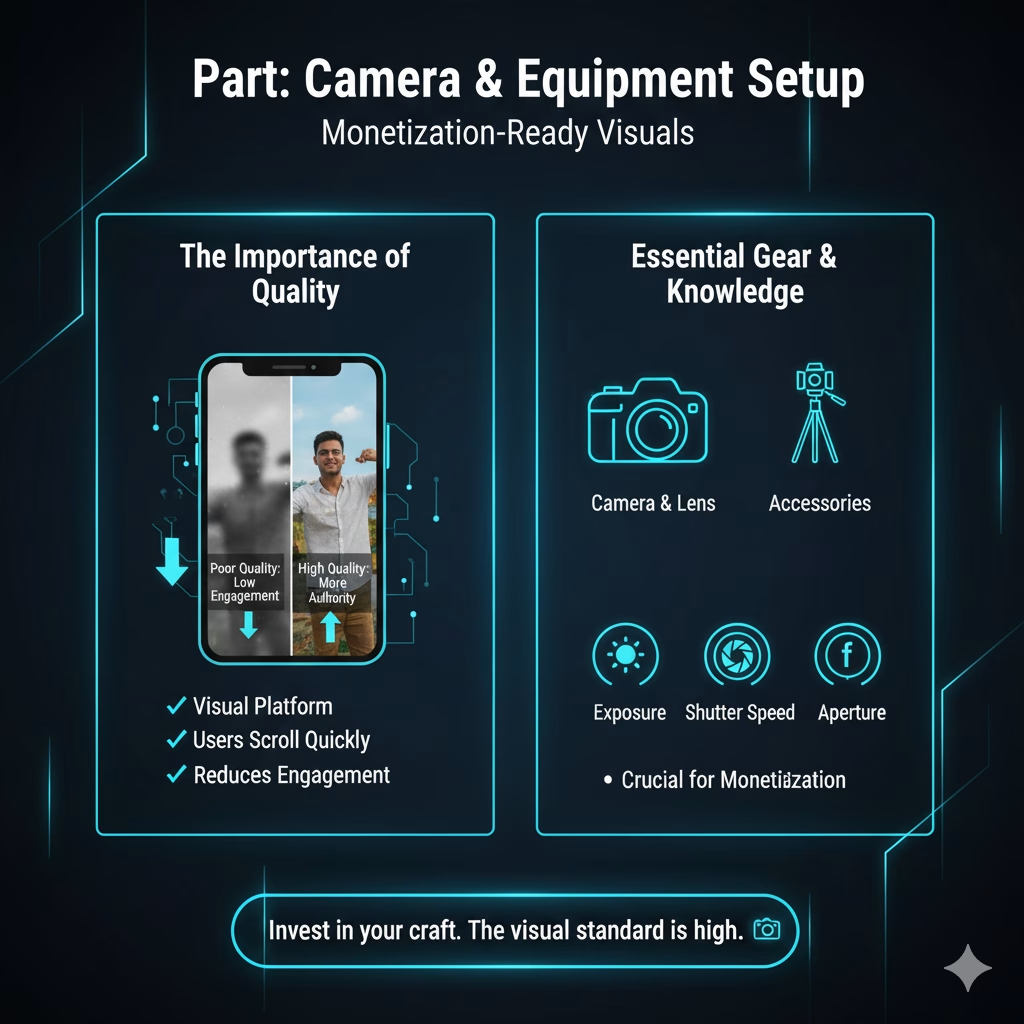
Camera Models: Beginners can start with smartphones equipped with high-quality cameras, such as the iPhone 17/18 series, Samsung Galaxy S26, or Google Pixel 12 Pro. For higher-end creators aiming for sponsorships, DSLR or mirrorless cameras are recommended. Popular options include Sony ZV-1 (compact vlogging camera with excellent autofocus), Canon EOS M50 Mark III (mirrorless, versatile lens options), Sony A7 VI (full-frame mirrorless for cinematic quality), and Panasonic GH7 (great for video with high bitrates and 8K 60fps). Your choice depends on budget, portability, and desired video quality.
Resolution and Frame Rate: Instagram supports up to 8K for feed posts and Reels, but 1080p at 30fps is standard and reduces file size while maintaining quality. For action-heavy content, 60fps allows smooth slow-motion. Set the camera to vertical orientation (9:16 aspect ratio) for Reels and Stories to maximize screen real estate on mobile devices.
Aperture (f-stop): Determines depth of field. For talking-head or influencer content, f/2.0–f/4.0 provides background blur, emphasizing the subject. For product shots or tutorials, f/5.6–f/8 ensures the product is entirely in focus. Keep in mind that smaller apertures require more light.
Shutter Speed: Use double your frame rate as a starting point: 1/60 for 30fps, 1/120 for 60fps. Higher shutter speeds reduce motion blur but require more light. For cinematic Reels, slightly lower shutter speeds can introduce natural motion blur, making content look smoother.
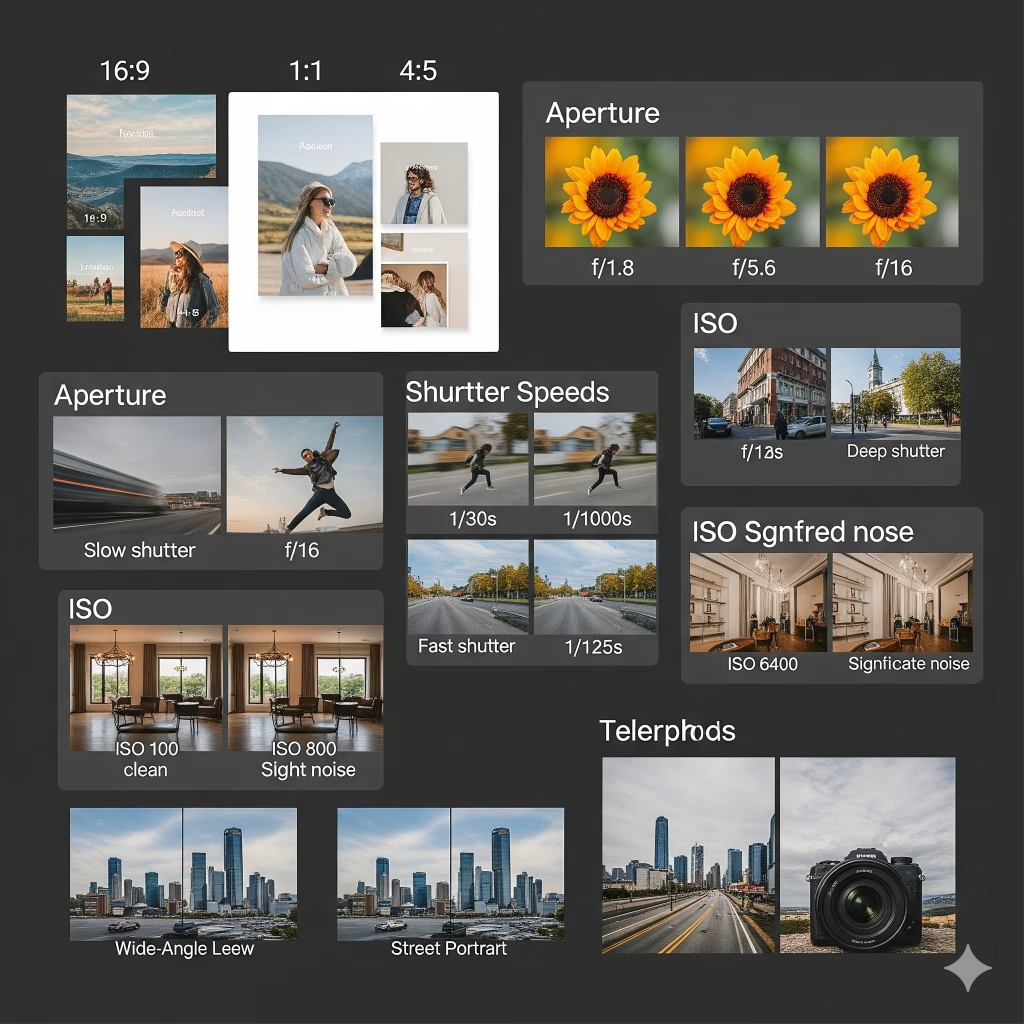
ISO Settings: Keep ISO as low as possible to avoid noise (grainy image). Indoor controlled lighting: ISO 100–400. For low-light or creative night shots, ISO 800–1600 may be acceptable, but balance with aperture and shutter speed to maintain clarity.
White Balance: Lock white balance to prevent color shifts. Daylight-balanced LEDs: 5600K. Warm indoor lighting: 3200–4000K. Smartphones often auto-adjust white balance dynamically, which can lead to flickering colors. If possible, set a fixed temperature or manual mode.
Lenses and Field of View: Wide lenses (24–35mm full-frame equivalent) are ideal for selfies, lifestyle, or environment shots. Standard lenses (50mm) work for portraits, product close-ups, and controlled studio setups. Ultra-wide lenses (16–20mm) are useful for travel or room tours but may introduce distortion near edges.
Tripods and Stabilization: For mobile creators, small tabletop tripods or ring-light stands with phone holders provide stability. For cameras, consider flexible tripods or gimbals (DJI Ronin-SC, Zhiyun Crane M2) for smooth motion shots. Instagram Reels often include moving shots; smooth footage improves engagement.
Lighting and Environment Setup for Instagram
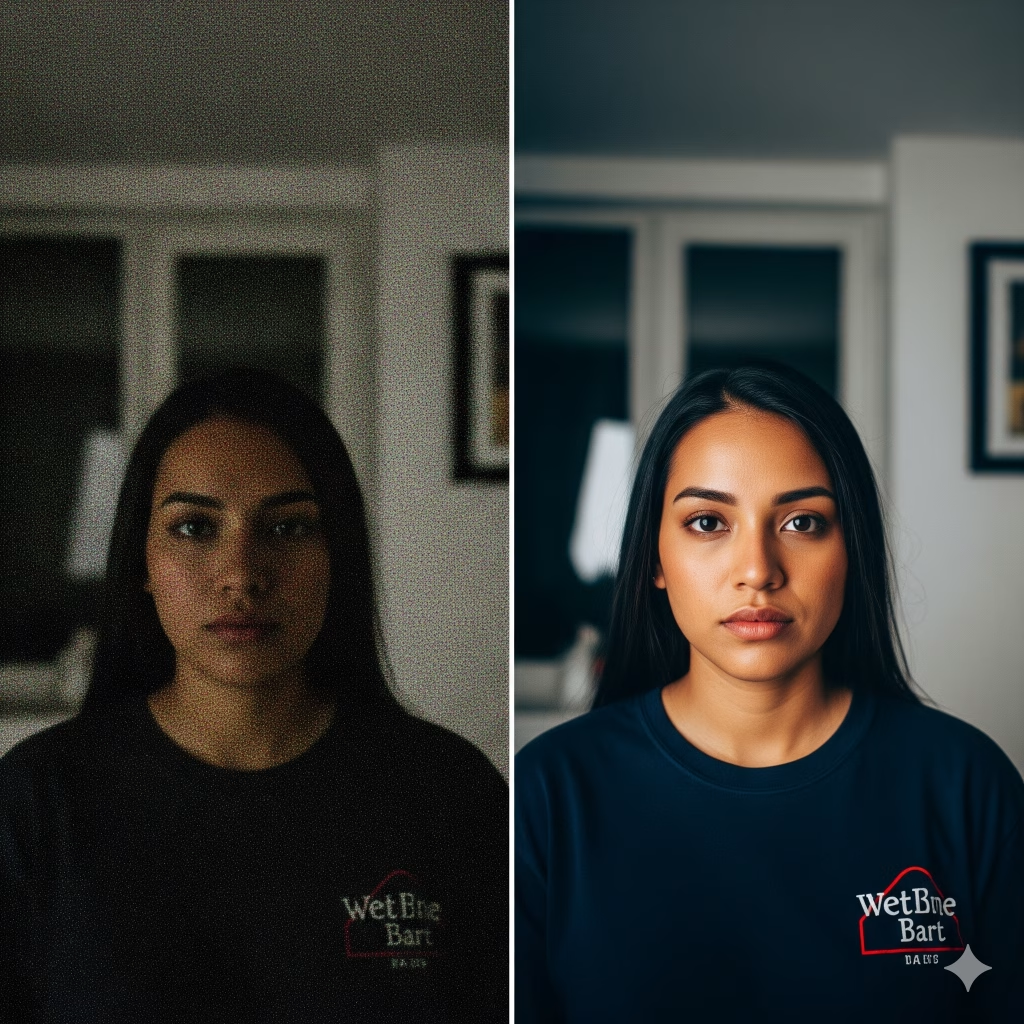
Three-Point Lighting Basics: Beginners should understand the classic three-point lighting system. It includes a key light, a fill light, and a backlight. The key light is the main light source, positioned at a 45° angle from the subject to illuminate the face evenly. The fill light is a secondary, softer light that reduces harsh shadows and is placed on the opposite side of the key light. The backlight, or hair light, separates the subject from the background, adding depth and preventing a flat appearance. Even with smartphones, this technique dramatically improves video quality.
Beginner Lighting Gear: For entry-level creators, a simple LED ring light with adjustable brightness and color temperature is sufficient. Popular choices include the Neewer Ring Light Kit. Position it directly in front of you for even lighting on the face. For product photography or tutorials, combine the ring light with a small side LED panel or tabletop softbox to reduce shadows and highlight details.
Intermediate and Advanced Lighting: Softbox lights and LED panels provide more control. LED panels like the Aputure Amaran 100d/200d allow adjustable intensity and color temperature. Softboxes diffuse harsh light, making skin appear smooth and reducing shadows. For multi-light setups, ensure consistent color temperature to prevent color mismatches between key, fill, and backlight. Use reflectors or bounce cards to fill shadows without additional lights.
Natural Light Optimization: Natural sunlight is free and high-quality but can be inconsistent. Shoot near windows with indirect sunlight for soft, flattering light. Avoid direct midday sun as it creates harsh shadows. Use sheer curtains to diffuse light or a white foam board to bounce sunlight onto the subject. Golden hour (first hour after sunrise, last hour before sunset) provides warm, cinematic light that works perfectly for lifestyle, fashion, or travel content.
Background and Environment: Clean, uncluttered backgrounds draw attention to the subject. Decorate minimally with props relevant to your niche: a desk for productivity content, plants for lifestyle, or colorful backdrops for creative videos. Pay attention to color contrast; avoid backgrounds that blend with your outfit. For outdoor shooting, position yourself so the sun is behind the camera to illuminate your face evenly. Avoid harsh shadows caused by uneven terrain or objects blocking sunlight.
Audio Setup for Instagram Content
Microphone Types and Recommendations: Choose your microphone based on content type and budget. Lavalier microphones like the Rode Wireless GO II or Boya BY-M1 are ideal for talking-head videos and mobile shoots, offering mobility and direct connection to cameras or smartphones. USB microphones such as the Blue Yeti or Shure MV7 work well for voiceovers, tutorials, or live streaming. Shotgun microphones like the Rode VideoMic NTG capture directional sound for controlled setups, reducing background noise.
Placement and Techniques: Lavalier mics should be clipped 15–20cm below the chin and outside clothing folds to prevent muffled sound. Shotgun mics should be placed just above or below the camera, angled toward the subject. Avoid direct contact with surfaces to reduce vibration noise. For outdoor shooting, use windshields or foam covers to eliminate wind interference. Smartphone internal mics are usable for casual content but are inferior for monetized projects.
Background Noise Control: Choose a quiet recording environment when possible. Eliminate fans, AC, or electronics that produce hum. Soft furnishings, carpets, or acoustic panels reduce echo in small indoor spaces. Outdoors, schedule filming during quieter times and use directional microphones to isolate the subject. For low-budget setups, blankets or DIY panels can effectively dampen unwanted reflections.
Audio Levels and Monitoring: Keep recording levels consistent to prevent clipping or distortion. Aim for peaks around -6dB on cameras or audio interfaces. Monitor sound using headphones to detect subtle issues. If using external audio recorders like Zoom H5 or Tascam DR-40, ensure proper gain settings and sync with video in postproduction using clapperboard or digital markers.
Integration with Instagram Features: Instagram Reels often incorporate music tracks, voiceovers, or sound effects. Exported audio should be normalized and synced precisely. For Stories, background music can enhance engagement, but dialogue must remain clear. Combining professional audio capture with careful postproduction ensures your content meets brand standards for sponsored posts and affiliate promotions.
Video Editing and Postproduction for Instagram
Choosing Editing Software: Beginners can start with mobile-friendly apps like CapCut or Adobe Premiere Rush, which are simple, intuitive, and support vertical video for Reels and Stories. Intermediate and advanced creators benefit from desktop solutions such as Adobe Premiere Pro, Final Cut Pro X, or DaVinci Resolve, offering multi-track editing, advanced color grading, keyframing, and precise audio control.
Editing Workflow: Begin by organizing clips into folders for raw footage, audio, and graphics. Rename files for easy reference. Trim dead space, mistakes, or unnecessary content. Sequence clips to create a coherent flow with strong pacing—Instagram audiences favor dynamic, engaging content with minimal filler. Add transitions carefully; jump cuts and crossfades maintain clarity and rhythm without overwhelming viewers.
Color Grading and Correction: Correct exposure, white balance, and contrast for consistency. Apply a creative grade for branding consistency across posts. Lifestyle accounts may favor bright, punchy colors, while luxury or cinematic niches may use desaturated tones with higher contrast. Always preview graded content on multiple devices, as Instagram is mobile-first, and color reproduction varies between phone models.
Audio Editing: Sync dialogue or voiceovers with video. Normalize volume levels, apply noise reduction, and balance music with speech. Instagram Stories or Reels often include music overlays, but spoken content should remain clear. Export audio in AAC format at 44.1kHz for optimal compatibility.
Text Overlays and Captions: Captions enhance engagement and accessibility. Add short, concise text emphasizing key points or punchlines. Use readable fonts and avoid cluttering the frame. Lower-thirds or branded watermarks help build recognition without distracting viewers.
Export Settings for Instagram: Vertical videos (9:16) for Reels and Stories, square or portrait (4:5) for feed posts. Resolution: 1080×1920 for Reels, 1080×1080 or 1080×1350 for feed. Frame rate: 30fps standard, 60fps for action or slow-motion. Codec: H.264, Bitrate: 8–12 Mbps, Audio: AAC stereo 44.1kHz. Test final exports on mobile devices to confirm clarity, audio balance, and aspect ratio.
For advanced editing tutorials and templates optimized for Instagram growth and monetization, see Adobe Creative Cloud Video Tutorials and Wemaxa for influencer-focused guides.
Instagram Monetization Methods
Once your Instagram content is high-quality, visually consistent, and engaging, monetization becomes achievable. Successful creators combine multiple revenue streams, leveraging both Instagram’s built-in tools and external partnerships. Understanding how each method works and optimizing content for it is critical to earning sustainable income.
1. Brand Sponsorships: Sponsored content remains the primary income source for Instagram creators. Brands pay for posts, Reels, or Stories featuring their products or services. Engagement rate often matters more than follower count: brands look for creators with strong likes, comments, shares, and saves. Professional video and audio quality, consistent branding, and high retention increase chances of securing sponsorships. Negotiate terms based on deliverables: single post, multi-post campaigns, or ongoing ambassadorships. Include affiliate or discount codes to add measurable ROI for the brand.
2. Affiliate Marketing: Promote products through affiliate links or discount codes. Platforms like Amazon Associates, ShareASale, or niche-specific affiliate programs allow creators to earn commissions for every sale driven. Reels and Stories with “swipe up” or sticker links are highly effective for product promotion. Always disclose affiliate partnerships to maintain transparency and comply with regulations.
3. Instagram Shop & E-commerce: Instagram Shopping allows creators to tag products directly in posts or Reels, driving sales within the app. Merchandising your own products, such as apparel, digital goods, or services, can complement affiliate or sponsorship income. High-quality photos and videos highlighting product benefits increase conversion rates. Carousel posts showing multiple angles or features are particularly effective.
4. Reels Bonuses and Instagram Programs: Instagram sometimes offers creator bonuses or payout programs for Reels with high engagement. Participation requirements vary by region but generally include follower minimums, consistent posting, and adherence to content guidelines. Track performance using Instagram Insights and optimize Reels for watch time, shares, and completion rate to maximize potential payouts.
5. Live Badges: During Instagram Live sessions, followers can purchase badges to support creators. Engaging live content, such as Q&A sessions, tutorials, or product showcases, encourages badge purchases. Build anticipation with Stories or feed posts announcing live events and provide exclusive value to incentivize purchases.
6. Cross-Platform Monetization: Extend Instagram content to YouTube, TikTok, or a personal website to diversify income. Repurposing Reels into short-form videos for TikTok or YouTube Shorts increases reach and ad revenue potential. Embedding affiliate links or directing traffic to digital products or email lists creates additional revenue streams beyond Instagram alone.
7. Analytics and Optimization: Constantly review engagement metrics, follower growth, and content performance. Identify high-performing content types, posting times, and formats. Optimize captions, hashtags, and CTAs to maximize engagement. Use data-driven decisions to pitch brands, plan affiliate campaigns, and schedule Reels strategically for maximum visibility.
REMEMBER:
- Choose niche and target audience
- Batch content and publish on a regular schedule
- Use Reels to reach new viewers and Stories to build loyalty
- Activate available monetization features early
- Promote a low cost offer to convert followers to buyers
- Measure performance and iterate every two weeks
Instagram monetization is a multi-layered process that combines professional content creation, audience engagement, and strategic revenue streams. By integrating sponsorships, affiliate marketing, Instagram Shop, Reels bonuses, live badges, and cross-platform promotion, creators can build sustainable income. High-quality video and audio, consistent branding, and strategic planning are prerequisites for long-term success.

